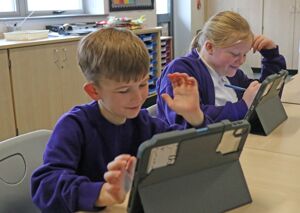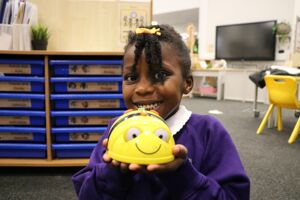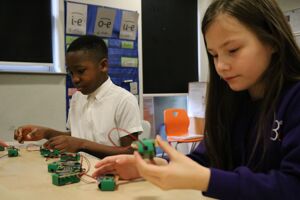- Home
- A360 Life
- Subject Information
- Computing
Computing
BackIntent
At Academy 360 we want children to be masters of technology. Technology is everywhere and will play a pivotal part in students’ lives therefore, we want to model and educate our pupils on how to use technology positively, responsibly and safely. We intend to create pupils who are creators and our broad curriculum surrounding computer science, information technology and digital literacy reflect this. As technology is evolving and creating greater opportunities, we want our pupils to understand that there is always a choice with using technology and as a school we utilise technology (especially social media) to model positive use. We recognise that the best prevention for a lot of issues we currently see with technology/social media is through education. We understand that technology can allow pupils to share their learning in creative ways and celebrate this. We also understand the accessibility opportunities technology can provide for our pupils. Our knowledge rich curriculum has to be balanced with the opportunity for pupils to apply their knowledge creatively which will in turn help our pupils become skillful computer scientists. We encourage staff to try and embed computing across the whole curriculum to make learning creative and accessible. We want our pupils to be fluent with a range of tools to best express their understanding.
At Academy 360 we aim for children in Key Stage 1 to gain confidence, develop their skills and gain knowledge and understanding of the subject. The intent is to encourage children to become better equipped to use their initiative enabling them to become more independent learners. Children are also exposed to continuous provision with computers and ipads allowing them to develop their skills independently whilst taking responsibility for their own learning. Providing children with the opportunity to take ownership encourages resilience and it develops problem solving skills, and it opens a student's eyes to the digital world. This can engage, enthuse and cause a real spark in students.
In KS2 we believe that every opportunity should be taken to develop and equip children with computer science skills. By equipping the children with real life transferable skills for the ever changing world we now live in. We aim to provide a vibrant learning environment where all children can achieve. The children access computer science through explicitly taught lessons and also integrated within cross curricular subjects. KS2 have access to up-to-date technology (Chromebooks) and it is essential for KS2 students to know how to use specific technology so they become digitally literate and are able to express themselves through information and communication technology, in a respectful and responsible manner. Computing has evolved in response to a changing world, and that the skills children learn in computing during their time at school will be invaluable, as the world of technology continues to change and grow at a rapid pace.
Each curriculum outcome falls in to one of the following areas:
- Computer Science
- Information Technology
- Digital Literacy
We intend to build upon the skills within KS1. By the end of KS2 the children will have been taught a broad and balanced ICT curriculum.
Information Technology
Learners should know that technology is everywhere, be able to identify the technology they encounter and have a growing understanding of how it works. We have broken down this part of computing into activities for word processing, spreadsheets and data handling, presentation, ebook creation, web design, animation, video creation, photography and art, sound and AR & VR. When using these ideas to create content everything should link closely to digital literacy – awareness of audience and good design principles. Pupils should experience a range of different apps and software. In KS1 teachers will select the programs to use but as pupils get older they should be encouraged to make their own choices. Learners also need to know how to store and organise their files online and locally so that it can easily be found again. KS1 uses Seesaw and KS2 uses Google Classroom.
Computer Science
Computer science is broken down into three strands: Computational Thinking, Programming and Computer Networks. Computational Thinking is all about solving problems effectively with or without a computer. Computational thinking is about looking at a problem in a way in which a computer can help us to solve it. This is a two-step process: 1. First, we think about the sequence of steps (an algorithm) needed to solve a problem 2. Then, we use our technical skills to get the computer working on the problem as we implement our algorithm as code. Programming is one application of computational thinking. Learners will write algorithms and implement these as code. They also need to be able to find mistakes and fix them (debugging.) Once learners have created a program they need to learn to evaluate and look at different ways to achieve the same goal and which method is most appropriate. As learners get older the programs they write will become more complex using a range of constructs such as sequence, selection, repetition and variables in their programs.
In KS1 it is our intention to enable the children to understand what algorithms are and how they are implemented. We do this through using beebots and creating our own instructions for our partners to follow and debug. Children develop understanding on how to create and debug a simple program by using computer programs such as Busythings, Code.org and Seesaw. We use apps such as times tables rock stars and stop start animation to develop logical reasoning which enables the children to predict the behaviour of a simple program. We aim that children will immerse themselves with technology enabling them too purposefully to create, organise, store, manipulate and gather data. We mainly do this through using apps which link to our topic theme eg. creating a green screen of a report from the fire of London.
In KS2 it is our intention to enable the children to design, write and debug programs that accomplish specific goals. We do this through a variety of ways such as using apps. This allows the children to experience different aspects of programming for a purpose. We equip children with the skills of sequence, selection, repetition in programs through working with word processors, multimedia presentations. We build upon KS1 skills and begin to develop a greater knowledge of the subject. This allows them to explain in greater depth how simple algorithms work and can detect and correct errors. We embed the use of technologies effectively through teaching cross curricular. By researching, discussing and selecting which information to use on how it is ranked. In KS2 the children combine a variety of software through creating presentations aimed at different audiences. We aim to embed this through cross curricular teaching building on the basic skills taught within KS1. The children use applications which are embedded within the Google suite such as Google docs and slides.
Digital Literacy
Today’s children and young people are growing up in a digital world. As they grow older, it is crucial that they learn to balance the benefits offered by technology with a critical awareness of their own and other’s online behaviour, and develop effective strategies for staying safe and making a positive contribution online. Our curriculum describes the skills and understanding that children and young people should have the opportunity to develop at different ages and stages. It highlights what a child should know in terms of current online technology, its influence on behaviour and development, and what skills they need to be able to navigate it safely.
Our students face a variety of risks and challenges when accessing the online world. In KS1 we intend to introduce them to how to use technology safely and respectively. The core principles of keeping information private and identifying where to go for help are embedded through celebration weeks such as anti-bullying week and internet safety day. We revisit e safety throughout the year to ensure the children are fully aware.
In KS2 we focus on recognising acceptable and unacceptable behaviours online. Identifying the risks and how to be responsible. It is vitally important that we continue to embed online safety through celebration weeks as well as through collective worship sessions. Addressing real life situations allows the children to see the impact their negative actions can have on one another. We also raise the profile and teach about unacceptable content and who to talk to if you need help and advice.
Hardware and computer systems
In KS1 we believe in preparing our children for a technological future. In order to do this we aim for the children to recognise common uses for information technologies. We do this through integrating ICT within our lessons enabling cross curricular learning. We introduce the children to the concept of blogging and tweeting allowing the children to see common uses in the wider technological world. In KS1 the children have regular access to various ICT equipment that develops their understanding and confidence.
In KS2 we aim to prepare the children for the ever changing technological future. We use ICT where it is appropriate in cross curricular learning. This allows the children to experience first-hand the use of IT and why this is valuable; allowing them to build upon skills for later in life. Children have individual Chromebooks which they use throughout their learning to gain confidence.
Impact
We encourage our children to enjoy and value the curriculum we deliver. We will constantly ask the ‘why’ behind their learning. We want learners to discuss, reflect and appreciate the impact computing has on their learning, development and wellbeing. Finding the right balance with technology is key to an effective education and a healthy life-style. We feel the way we implement computing helps children realise the need for the right balance and one they can continue to build on in their next stage of education and beyond. We encourage regular discussions between staff and pupils to best embed and understand this. The way pupils’ showcase, share, celebrate and publish their work will best show the impact of our curriculum. We also look for evidence through reviewing pupil’s knowledge and skills digitally through tools like Google Drive and Seesaw and observing learning regularly. Progress of our computing curriculum is demonstrated through outcomes and the record of coverage in the process of achieving these outcomes.
Primary
Position Statement
In delivering ICT at Academy 360, we aim that the teaching of information technology will enable children to use computational thinking and creativity to understand and change the world. The need to have a clear understanding of the principles and practices of computer science in order to be prepared for careers in the 21st century in a computer-intensive world.
Computational thinking will be a fundamental skill used by everyone in the world by the middle of this century. The study of computer science is a catalyst for the development of computational thinking skills. Computer science being strongly based upon higher tiers of cognitive taxonomy as it involved design, creativity, problem solving, and analysis of solutions to problems. At Academy 360 we offer a variety of ways in which children can develop their computer science skills. We have iPads, computer suites, the green screen room, laptops and the 3D room. Pupils are encouraged to work independently and confidently. The introduction of the iPads and green screen/3D room provides the opportunity for the children to master such skills and meet the national curriculum's high expectations.
Computing has deep links with mathematics, science and design technology. We aim to provide a balanced and broad curriculum with cross curricular links using computer science in other subjects. Children will be provided with first hand experiences in order to inspire, motivate despite their need or ability.
Our curriculum is continuously monitored and adapted to ensure all of the learning objectives are met and that essential skills are taught at every level, allowing children to reach mastery level. The development of our outdoor area will allow more access to using computer science outdoors. Through both key stages children will have the opportunity to be able to understand and apply the fundamental principles and concepts of computer science, including abstraction, logic, algorithms and data representation. Children will develop the ability to analyse problems in computational terms, and have experience of writing computer programs in order to solve problems. Once written children will be encouraged to evaluate and apply information technology, including new or unfamiliar technologies, analytically to solve problems which have arisen. Overall, we aim for children to become responsible, competent, confident and creative users of information and communication technology
Computer science should be taught for an hour a week every other half term, although there is room for flexibility and teachers will plan the delivery of the subject carefully to maximise motivation and inspiration. Most year groups often deliver computer science through other subjects. This enables the teacher to have more flexibility when planning the children's interests. Computer science is delivered through use of apps, games and independent research.
Overall computer scientists will learn through a variety of abstract and practical activities and become digitally literate – able to use, and express themselves and develop their ideas through information and communication technology – at a level suitable for the future workplace and as active participants in a digital world.



Computing-Subject-Overview--1.pdfProgression-Map-Computing-1.pdf
Secondary
Please see the link below for an overview on the Secondary curriculum for Computing.
